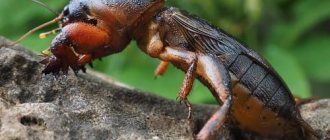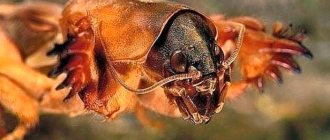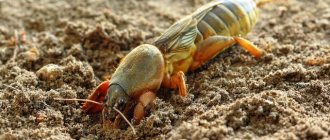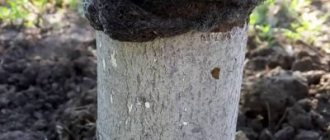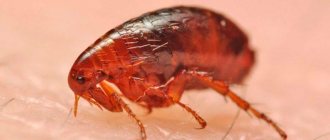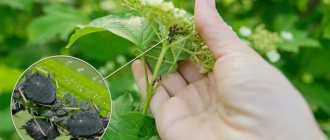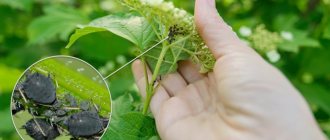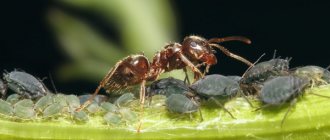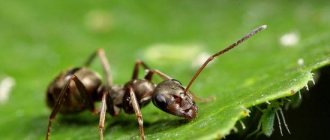Having seen long, winding, lumpy swellings of the earth in the garden, one can say for sure that it was a mole cricket making its underground passage. Such paths are especially noticeable on wet ground. Typically, such swellings on the surface of the earth have a length of 10 cm. And if you look around, you can see either nibbled stems of tomatoes, eggplants, peppers, cucumbers, or a couple of pea-sized holes leading into the depths of the soil and located next to each other. If you find this on your property, then you are undoubtedly interested in the question: “how to get rid of mole crickets in the garden forever?”
In order to create ventilation in the nesting box, the female breaks through paired holes, from which it can be determined that there is a clutch deep in the ground. And perhaps the young have already hatched there, and after some time they will attack the roots, stems and tubers. But people hope to get a harvest, and not stubs from tubers and seemingly mowed seedlings. The mole cricket loves young cabbage sprouts, which is why this insect received another name: “cabbage weed”.
What does a bear look like: photo
An adult mole cricket is impressive in size for an insect. With an abundance of food, it can reach 5-6 cm in length. The front legs resemble short, thickened claws, only they are not forked, like a crayfish, but have 4 powerful teeth. She uses her paws like shovels to dig underground passages. There are 2 more pairs of paws on the abdomen. The hind ones are the longest, like those of a grasshopper.
The hard, chitinous dorsal covering of the body of an adult is dark brown in color and appears shiny due to numerous golden hairs. The mole cricket has a wide head and a long (almost 3 times longer than the head) abdomen. The head contains strong jaws, tentacles, large eyes and long whiskers. Under the knees of the front legs in a deep fold are the ears.
What does a bear look like (video)
The wings of the mole cricket are well developed; when folded, they appear to be bent downwards in cords and protrude from under the short elytra. Thanks to its wings, it can fly quite long distances. Lives underground, but at the same time, not only flies well, but also runs fast.
The mole cricket overwinters in compost heaps and in the ground, at a depth of 1 m; the larvae of the first year of life in winter do not fall lower than 20-25 cm. When the soil warms up to 12-15 ° C, the insect comes out of hibernation. Mating of insects occurs in the spring. Offspring will appear in warm weather in summer. Each nest can contain several clutches. Each clutch contains from 50 to 400 eggs. From oval yellowish-gray 2 mm eggs hatch wingless larvae, which in appearance are similar to gray six-legged spiders.
Mole cricket masonry
For the first 20 days of life, the larvae live in the clutch, and then crawl into burrows, make new passages and begin to actively feed on roots, fruits and seeds. When the nest is torn apart, it is clear that the grown larvae are very active, run fast, and can even jump. The age of the larvae is divided into several stages of molting: the youngest are 15 mm in length, the larvae of the 4th stage already have the rudiments of wings, the larvae molt up to 10 times. The larvae reach adult size only the following year. The full development cycle of the pest lasts 2 years.
Traps
Physical methods for exterminating agricultural parasites involve the construction of special traps using toxic substances. A trap based on a broad-spectrum biological product is a real eco-killer. It destroys harmful insects on an industrial scale.
Parasites are lured into pits with manure. Cypermethrin or chlorophos is used as a toxic compound. After 3 weeks, the contents are removed and burned. To protect potato crops, holes are formed with a pesticide. Karbofos and carbide work well. To activate the poisonous properties of the latter, watering or damp weather is required.
Reasons for appearing in the garden
The invasion of cabbage weeds in the garden can be facilitated by adding fresh organic fertilizer to the soil, regardless of whether the product was applied to increase the fertility of the soil on your own plot or on a neighboring one. Mole crickets can overwinter in any manure, although some gardeners claim that fresh chicken manure is used specifically to get rid of the pest. The second reason for the appearance of cabbage mushrooms can be waterlogged mulched soils, as well as lands where groundwater is located near the surface layer.
When are protective equipment needed?
The orthoptera pest loves soil fertilized with humus, horse and cow manure. Medvedka:
- has good adaptive abilities;
- Reacts sensitively to increases and decreases in temperature;
- detects danger.
The pest prepares for winter in advance, trying to find a warm place. The mole cricket gnaws a large volume of vegetable fruits in a few hours.
The basis of the pest's diet is:
- roots;
- cabbage;
- squash;
- cucumbers;
- tomatoes;
- pepper;
- decorative flowers.
The insect is hardy and has a significant resource of physical strength.
Attention! The mole cricket population is capable of destroying the entire crop on the site. Therefore, at the first sign of the appearance of a pest, it is necessary to apply crop protection products.
Traditional recipes do not always give good results in killing mole crickets. In this case, synthetic drugs are used. They hit the insect outright. The principles of mole cricket extermination vary depending on the climate and time of year, the chemical and physical-mechanical characteristics of the soil, the characteristics of the cultivated area and the plants grown.
How to get rid of mole crickets forever
Several generations of gardeners can fight mole crickets on the same plot of land. The result will be positive only when this is done not by a single farm, but by the majority of gardeners in the area. But, in any case, it is possible to reduce crop losses even when you do not have to count on the support of your neighbors.
After all, sometimes there may be people living nearby who, due to age or strength of health and spirit, are not able to dig holes in order to destroy the egg-laying cabbage grass; set traps and then manually destroy still living insects; make protective fences from plants with roots that are poisonous to the pest; use chemicals - some of them can be expensive.
Purchased funds
Chemicals used to combat mole crickets are mainly toxic substances of contact-intestinal action. Chemical reagents included in such products as “Parachute”, “Grom”, “Bankol”, “Medvetoks”, “Rembek”, “Antimedvedka”, “Vofatoks”, “Aktara”, “Antikhrushch”, “Metafos” affect the nervous system. the cabbage system, after which paralysis and death of the insect occurs. These products act not only on mole crickets, but also help get rid of other pests in the garden.
Usually these products are harmless to plants and warm-blooded animals and people. The duration of action of chemicals is from 15 to 30 days, then they disintegrate in the soil into neutral components. The preparations must be diluted according to the manufacturer’s instructions and the solution should be sprayed onto the plantings, and also added to porridges seasoned with aromatic sunflower oil, which are then used as bait. Baits are laid out near places where insect passages are visible, in holes sprinkled with earth around plants, in the aisles.
When using chemicals, you must first study the manufacturer's instructions and protect yourself from the harmful effects of toxic reagents.
Biological agents that destroy cabbageweed are not packaged in bags or glass flasks, but crawl, fly and run on their own. Chickens, hedgehogs, starlings, crows, toads and frogs, even some domestic cats, having once tasted the mole cricket, always hunt for pests as soon as they see them on the surface of the earth. A family of starlings, for which a birdhouse will be hung on the ridge of a garden house, will, of course, not be able to completely get rid of insects, but will significantly reduce their number.
Many gardeners carry out protective plantings around their beds. For fences, lupine bushes are used, the roots of which contain a toxic substance, which, when eaten, kills pests. The American weed (galinzoga) is specially harvested in the period preceding its flowering, and then scattered between the beds. Mole crickets cannot stand the smell of this grass. Low-growing black marigolds (marigolds) with the aroma of their roots and flowers repel not only adult individuals, but also growing insects that are constantly in the ground.
Folk remedies
Kerosene is used to use its smell to drive away harmful insects from vegetable crops. Kerosene in an amount of 50-70 ml is mixed with 1 kg of sand and 2-3 shovels of earth. The mixture is added to the planting holes and spread between the plants.
Soapy water is poured into the discovered holes and passages of pests. Sometimes it is enough to pour only 2-3 liters of water into a hole, with washing powder (the cheapest) dissolved in it, to drive an adult insect out of the ground. In this case, you need to prepare in advance and put on gloves on your hands, because you will have to catch the pest.
Eggshells help protect seedlings from being eaten by mole crickets. Crushed shells, soaked in fragrant vegetable oil, are laid out to a depth of 3 cm around the plant at the time of planting in the hole. The insect, crawling towards the root to follow the smell, stumbles upon the bait, swallows it and dies.
Karbafos is used for poisonous baits made from boiled bran or cereals. For example, for 1 kg of boiled oats, use 50 g of unrefined cold-pressed sunflower oil and 50 g of karbafos. Mix everything thoroughly. The bait is laid out in shallow holes around the garden, which are covered with earth so that birds and animals cannot eat them and die along with the mole cricket.
The trap can be a champagne bottle, dug into the ground at an angle of 20-30° with a depth of 2-3 cm. A small amount of either beer, wine, or sweet bait is poured into the bottle. The neck of the bottle must be covered with one layer of gauze - insects gnaw through the fabric and fall to the bottom of the bottle, from which the owner of the garden will subsequently remove it.
Some mole crickets bypass protective rings made from cut plastic bottles quite easily, penetrating to the roots of the plantings underneath. But still, many gardeners manage to save the crop from the pest by placing plastic rings up to 7 cm high on the seedlings at the time of planting in the ground. The main thing that needs to be done is to bury the ring into the soil by 3-4 cm.
Chemical methods
Chemicals designed to combat garden pests contain potent poisons that are dangerous not only for insects, but also for humans. Therefore, I recommend that you pay attention to the following precautions:
- Carry out the treatment when there are no small children or pets on the site.
- Take care of your own safety: wear thick rubber gloves, closed clothing and shoes, a respirator, a hat and safety glasses.
- Use separate containers and tools for processing. Clean and store these items separately.
- Follow the manufacturer's instructions exactly - do not exceed the dosage.
Chemicals can be divided into two groups:
- Granules: “Phenaxin Plus”, “Thunder”. The products do not require dissolution in water - they are scattered in mole cricket burrows and placed in sweet baits. The insect eats the “delicacy” and dies from the poisons it contains. Granular preparations are highly effective, but very toxic. Eating them by pets, beneficial insects and birds leads to serious poisoning or even death.
- Powders for preparing solutions: “Masterpiece”, “Akara”, “Prestige”. From a spray can or spray bottle, the product is sprayed onto the seeds and root system of seedlings. The drug acts already in the substrate, without harming the harmless terrestrial inhabitants of the garden.
I will present the drugs against mole crickets that are popular in garden centers:
- "Sarin";
- "Antimedvedka";-
- "Boverin";-
- "Medvetox";
- "Grizzly";
- "Frontier";
- "Medvecid";
- "Regent";
- "Rubit Rofakoks";
- "Rembek".
An alternative to chemicals is biologically active drugs. These substances contain spores of pathogenic fungi that are deadly to mole crickets. Once in the insect's body, they begin to actively reproduce. The activity of fungi leads to the subsequent death of the mole cricket.
Prevention
You can find out that mole crickets have settled on the site by the characteristic chirping sound that males make during the mating period in the spring. Double holes and twisting underground paths protruding outwards should leave no doubt that there is a clutch of pest eggs in the ground. Only deep autumn and spring digging of the garden can destroy the passages and lairs of insects.
In winter, insects go into hibernation, choosing warm dung heaps for this. In order to accurately find mole crickets in these heaps, ditches are dug into which well-compacted manure is placed, and the whole heap is insulated on top with straw. On frosty days, when the temperature on the soil surface is just below “0”, manure is scooped out of ditches and spread on the ground in a thin layer. The insect fails to return to the frozen ground and dies.
Traps for mole crickets can also be made in early spring. Manure is laid out in heaps around the site, and the heaps are watered with honey solution or alcohol-containing liquids. Periodically, the heaps are raked, insects are caught from them and destroyed.
Mole cricket trap
Benefits and harms
The mole cricket has a dual nature - it brings benefits and harm. Which side of the scale its status falls depends on its numbers. Even one mole cricket can destroy a flowerbed or garden bed. This insect digs very extensive systems of corridors in the ground. One individual can create up to 30 m of tunnels during the season. Usually at least one family lives in the garden.
The corridors formed by the insect are located at a height of about 5 cm below the surface of the earth. Therefore, while digging, the insect damages the roots of plants, gnaws them, and bites them. This quickly leads to plant death or significant damage.
During the day, mole crickets break through corridors, snack on underground parts of plants, and at night they come to the surface to finish their feast on above-ground parts of plants. The female trims the roots of plants above the nests so that heat from rotting plant debris will warm the laid eggs.
Mole crickets feed not only on the roots and young shoots of plants - they are omnivores!
What does a mole cricket eat at a summer cottage and symptoms of damage:
- Obvious, large cavities in potato tubers indicate the presence of a pest.
- May damage tomato shoots.
- They gnaw the roots of root vegetables (beets, carrots, parsley, celery, radishes).
- They affect the underground parts of tuberous plants (parsnips, dahlias, cassava).
- They are often predators - they eat snails, larvae, wireworms, and earthworms.
Most plants sown in flower beds die by accident. The mole cricket, in search of insects, forms a network of corridors in the soil. If plant roots appear in its path, it undermines them and, without soil around them, they begin to dry out - on the surface we observe withering, yellowing, and drying out of plants, despite the fact that the insect does not bite the roots. Sometimes plants collapse into tunnels built by the pest.
Why is mole cricket useful:
- The insect loosens and aerates the soil.
- Avid fishermen know that mole crickets are the best bait for catfish. Some fishermen grow mole crickets at home or buy them. It is also an excellent bait for pike.
- Eats larvae and eggs of snails and slugs that destroy vegetable crops. These insects are much less harmful than snails, so if there are not very many of them, they are useful.
- Mole crickets (especially young individuals) swim well, so in reservoirs and ponds they help curb some harmful insects that breed in the water.
Reviews
I make bait from root vegetables. In the spring, I plant last year’s carrots or beets in the ground, while scratching the surface skin to increase the smell emanating from the vegetable. When there is practically no greenery around, mole crickets crawl to the carrots to feed. And I dig poisonous porridge around the plant. So she dies.
Svetlana, 34 years old, Volgograd
I make ultrasonic repellers myself. I drive pieces of metal rods into the ground and put empty tin cans with a capacity of at least 0.5 liters on them so that they do not fly off in the wind. But they rattle a lot in the wind. That's why the mole crickets scatter. In any case, the plants next to the scarecrows are intact.
Dmitry, 49 years old, Krasnodar
Natalia
Author
Ask a Question
Fighting mole crickets is quite a tedious task; for many, the very sight of insects is unpleasant. But there's no escape. If you have already planted plants in the garden, then it is necessary that by the fall the harvest that you were counting on when planting still grows. Therefore, we arm ourselves with folk remedies, add chemicals to them, and the harvest is guaranteed, and the pest will be exterminated until next year. Health to you and your loved ones!
Fighting mole crickets in a polycarbonate greenhouse
Insects often damage crops in greenhouse conditions. In this case, too, there are ways to help your crops.
Thus, against insects in a greenhouse, it is recommended to use natural repellents - chrysanthemums or marigolds.
The gardener only needs to plant these flowers around the greenhouse so that the smell of the plants drives pests away from vegetable crops.
This method has proven itself well, and it is completely safe.
You can also bury pieces of fish next to the crop, which will begin to rot and scare away the pest. This method is often used for greenhouses.
DIY poison
Mole cricket baits with boric acid
For those who do not want to introduce poisonous chemicals into the soil, you can try preparing the poison yourself. Boric acid will be used as poison. You can buy it at the pharmacy. It is available in the form of a solution. In specialized stores the substance is offered in powder form.
This poison for mole crickets acts in two ways:
- Contact. When the pest comes into contact with the substance, the poison penetrates through the legs and chitinous shell. The result is paralysis of internal organs and inevitable death.
- Intestinal. The most effective and fastest way. To do this, you need to prepare bait, since the mole cricket will not use boric acid in its pure form. If ingested, the substance also causes paralysis.
It is recommended to use buckwheat, pearl barley or rice as bait. Cook the porridge as usual, slightly increasing the amount of water to achieve a thinner consistency. Mix boric acid into the prepared bait and spread it over the area, paying special attention to insect burrows.
Important!
When preparing poison, you must use personal protective equipment: gloves, clothing, goggles.
Boric acid will help eradicate the entire colony of pests from the garden, since the adults will feed the larvae with poisoned food. The effect of this poison lasts for 2 weeks. The result is noticeable after 10-14 days.
Natural enemies of cabbage grass
Birds are not averse to feasting on insects: rooks, starlings, crows. In the southern regions, storks actively exterminate cabbageweed; the main thing is to attract the insect’s natural enemies to the site.
To do this, they build birdhouses, feed the birds, and do not destroy the nests.
Hedgehogs will help reduce the population of earthen crayfish. For these useful animals, secluded places are arranged in areas (in lowlands, near rotten trees, near hedges). Another group of helpers are ground beetles, lizards, shrews, and centipedes.
A species of burrowing wasp, Larra anathema, poses a serious danger to cabbageweed. The solitary black wasp is known for its care of offspring and its original way of laying eggs. She chooses a mole cricket for the nest, looking for insects in the underground labyrinths of burrows. Drives the pest to the surface, stings, causing temporary paralysis and during this time manages to lay one egg under the insect’s foot.
After some time, the mole cricket comes to life, crawls into its hole, and the sand wasp larva successfully develops, parasitizing on the body of the insect. Shortly before the wasp pupates (approximately 15-30 days after laying), the mole cricket dies. This is how the Larra wasp helps a person fight a dangerous pest.
Lures
To attract beetles, aromatic compounds and food additives are used. Baits are prepared on the basis of mashed potatoes, vegetable oil, and various cereals. To protect grain crops and annual herbaceous plants, Triathlon is used, a three-component post-emergence herbicide with systemic action. If an area is heavily infested with mole crickets, ticks and whiteflies, use the contact acaricide “Sturm”, which destroys parasitic insects en masse and at all stages of development.
Biological drugs: is it worth using?
Nowadays, biological products that are considered environmentally friendly are actively used in pest control. Another “advantage” of such products is the lack of resistance in insects, which is often noted with traditional insecticides.
Operating principle: colonization of the pest’s body by fungi or predatory insects that parasitize at the expense of the host (mole cricket, wireworm).
The following remedies will help you get rid of mole crickets:
- Nemabact is a symbiosis of bacteria and a certain subspecies of nematode. The predator is distinguished by its reproduction speed, when used it gives an effect of up to 70-80%;
- Antonem-F is a drug similar to Nemabact, differing only in the type of nematode;
- Boverine is a drug based on the spores of a fungus of the Deuteromycetes species, which causes the disease muscardinosis. The peculiarity of the action is germination in the body of the mole cricket, poisoning of larvae and adults, infection of insects in the entire population.
But the use of biological agents is associated with difficulties:
- effective only at certain soil moisture and temperature levels;
- The preparation of biological products requires strict adherence to the recipe and deadlines.
